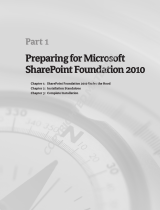
Tree Panel Behavior in Failover Cluster Environments .............................................................................................31
Tree Panel Nodes........................................................................................................................................................... 31
Tree Panel Icons............................................................................................................................................................ 33
Group SharePoint Farm Nodes, Clusters, or Host Nodes........................................................................................34
About Aliases..................................................................................................................................................................35
Customize Color Themes................................................................................................................................................... 36
Change the Color Theme for ASM/ME..................................................................................................................... 36
Change the Color Theme for the Volume View.........................................................................................................36
4 HIT Groups................................................................................................................................ 37
Overview of HIT Groups.....................................................................................................................................................37
ASM/ME Operations on HIT Group Members.......................................................................................................... 37
HIT Groups in Non-Cluster Environments..................................................................................................................37
HIT Groups in Cluster Environments...........................................................................................................................38
Create a HIT Group — Overview..................................................................................................................................... 40
Prerequisites for HIT Groups....................................................................................................................................... 40
Create a HIT Group With the Add Hosts Wizard....................................................................................................... 41
Edit ASM/ME Settings on Hosts in a HIT Group.............................................................................................................41
5 General ASM/ME Operations...................................................................................................... 42
About Volumes.....................................................................................................................................................................42
View Volume Details......................................................................................................................................................42
About Thin-Provisioning Volumes in HIT/Microsoft................................................................................................. 43
Operations on Failover Clusters.........................................................................................................................................43
Identifying Cluster Volumes in the ASM/ME GUI..................................................................................................... 44
About Collections.................................................................................................................................................................44
Volume-Based Collections............................................................................................................................................44
Create a Collection........................................................................................................................................................ 44
More Collection Operations......................................................................................................................................... 45
About Schedules..................................................................................................................................................................45
Retained Copies or Replicas.........................................................................................................................................45
Recommendations for Schedule Creation..................................................................................................................46
Constraints for Schedules............................................................................................................................................ 46
Schedules in Cluster Environments.............................................................................................................................46
Create a Schedule for Smart Copies.......................................................................................................................... 46
Modify a Schedule.........................................................................................................................................................46
Delete a Schedule.......................................................................................................................................................... 47
Enable a Schedule..........................................................................................................................................................47
Disable a Schedule......................................................................................................................................................... 47
Schedules for Thin-Provisioning.................................................................................................................................. 47
About Smart Copies............................................................................................................................................................48
Torn Smart Copies.........................................................................................................................................................48
Requirements for Creating Smart Copies.................................................................................................................. 49
Constraints for Smart Copy Operations.....................................................................................................................50
Create Smart Copies.....................................................................................................................................................50
Smart Copy Properties for Volumes............................................................................................................................51
View Available Smart Copies........................................................................................................................................ 51
View Smart Copy Details..............................................................................................................................................52
Smart Copy Validation ................................................................................................................................................. 52
Contents
5





















